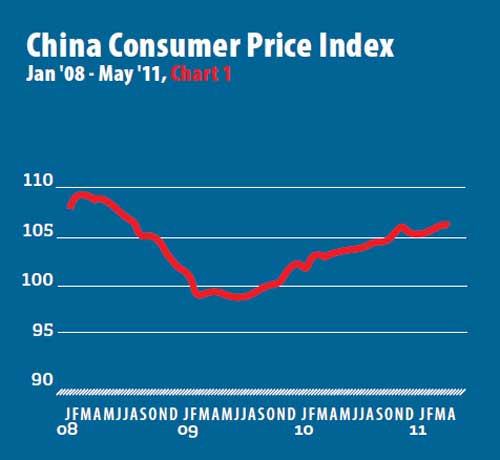|

More Inflation, More Tightening
The most important indicator in China right now is still the Consumer Price Index (CPI), and it is progressively heading toward 6 percent. This is leading Chinese Government to prolong monetary tightening measures, and this in turn is inhibiting the flow of credit and reducing manufacturing growth in China.
As reported several times in previous editions of the Econometer in 2011, inflation undoubtedly remains a fundamental challenge facing China's economy. In May, the CPI inched up further still, rising by 5.5 percent year-on-year, and 0.2 percent month-on-month (see Chart 1). CPI in China is now at the highest level since the 6.3 percent of July 2008 (just before the financial crisis started hitting home in a big way), making May's CPI a 35-month high. As reported in last month's edition of the Econometer, the rise in prices is mainly attributed to a rise in the cost of food, which in turn has been attributed to the severe drought of the last few months in China's agricultural heartland. In May, pork prices rose by more than 40 percent year-on-year. The Chinese Government was aiming for an average inflation rate of 4 percent in 2011, yet China now seems headed for 6 percent CPI growth before long.
This high rate of inflation is casting a shadow over the economy, and is a leading contributor to ongoing monetary tightening measures. These tightening measures are in turn slowing down industrial growth. In May, the official Purchasing Managers' Index (PMI) dropped by 0.9 to reach 52.0 (a reading above 50 indicates growth in manufacturing activity). The May figure is in fact the lowest reading in nine months. Zhu Baoliang, chief economist at the State Information Center of China, ascribed the drop in manufacturing output to reduced consumption. The termination of the government stimulus program, for example, he noted, has in recent months led to a decline in auto sales. In addition, tighter credit (see below) in May likely caused companies to run down existing stocks rather than acquire new ones.
As a result of the tightening measures described above, the supply of credit became tighter in May. Around 551.6 billion yuan ($85 billion) in new loans were extended in this month, significantly lower than the 739.6 billion yuan($114 billion) extended in April and 100.5 billion yuan ($15.5 billion) less than the same period in 2010. In the middle of June, China's central bank also again raised reserve requirements for China's banks by 0.5 percentage points, the sixth such adjustment in 2011.
|